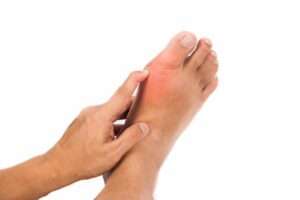Gout
Gout is a unique form of arthritis caused by needle-like crystals forming in your joints. Unlike osteoarthritis, which involves wear and tear on the joints, or autoimmune conditions like rheumatoid arthritis, gout is primarily caused by an excess of uric acid in the bloodstream. These uric acid crystals accumulate in the joints, causing intense pain, inflammation, and swelling. Most commonly, gout affects the big toe joint, but it can also impact other joints in the body.
What Causes Gout?
Gout occurs when the body produces too much uric acid or fails to eliminate it efficiently. Uric acid is a natural waste product that forms when the body breaks down purines, substances found in certain foods and drinks. If the kidneys aren’t able to clear the uric acid fast enough, or if you consume excessive purine-rich foods and alcohol, the concentration of uric acid in the bloodstream rises. This leads to the formation of urate crystals in the joints, resulting in a painful flare-up.
Who Is at Risk of Gout?
While anyone can develop gout, it is more common in men aged 40-50. Several factors can increase the risk of developing gout, including:
- Kidney disease or impaired kidney function that affects the body’s ability to clear uric acid
- Medications like diuretics, which increase uric acid concentration
- Obesity, high cholesterol, high blood pressure, or glucose intolerance
- Dietary factors, such as consuming alcohol, red meat, shellfish, and foods high in purines
Historically, gout was referred to as the “rich man’s disease” because wealthier individuals often consumed diets rich in purines, leading to a higher incidence of gout. Foods like alcohol, seafood, meats like liver, and rich cuts of meat are common culprits.
Signs and Symptoms of Gout
A gout flare-up typically begins suddenly, often without warning. Symptoms include:
- Severe pain, especially in the big toe joint, but it can affect other joints too
- Swelling and redness of the affected joint
- Warmth around the joint
- Intense pain with even the lightest touch, such as from bedsheets at night
A gout flare can last from a few days to weeks. Over time, repeated flare-ups may lead to permanent joint damage, resulting in stiffness and more chronic pain.
Treating Gout and Foot Care
If you are experiencing your first gout flare, it is important to see a doctor for diagnosis and medication to prevent future flare-ups. While gout cannot be cured entirely, proper management can help control the condition.
Once diagnosed, podiatric care becomes an essential part of managing gout’s effects on your feet. Our podiatry team at Leading Health Podiatry can help by:
- Custom foot orthotics: Designed to off-load painful joints, relieve pressure, and provide stability for more comfortable walking
- Footwear advice: Recommending shoes or custom footwear to enhance comfort and minimize stress on affected joints
- Lifestyle tips: Offering guidance on avoiding triggers such as high-purine foods, managing weight, and staying active
- Pain management: Using various techniques to help alleviate discomfort during a gout flare
Our goal is to help keep you mobile and independent, managing both the acute symptoms and the long-term effects of gout to ensure you maintain your quality of life.
Prevention and Long-Term Care
Managing gout requires a long-term approach to prevent future flare-ups and joint damage. Our podiatrists work closely with you to:
- Advise on dietary adjustments and lifestyle changes to reduce uric acid buildup
- Guide you in using preventive measures like wearing warm socks during a flare-up to help ease pain
- Help manage joint deterioration and stiffness with appropriate foot care
If you’re looking for expert treatment and support for gout, including tailored foot care, contact Leading Health Podiatry today.

